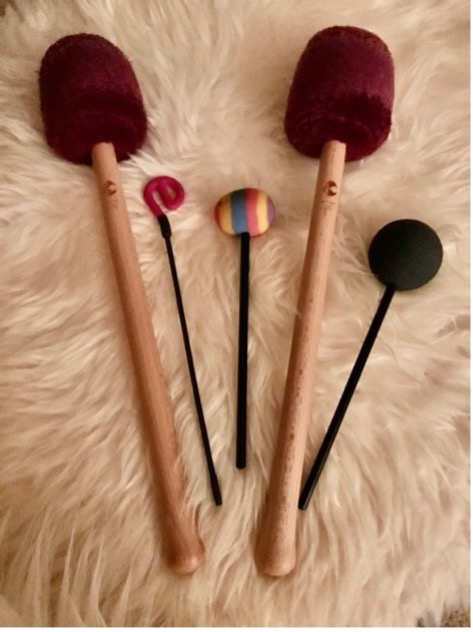Explore and the essential basics of the Chao Gong
Have you thought about buying a Chinese Chao Gong? Do you wonder what it might be like to play a Chao Gong? This gong has a ruggedness to it, none of the polished shine and finish of the European gongs, but a basic rudimentary nature that is solid, heavy, and fundamental. It has a very earthy sound and produces a wide range of harmonics or overtones. My first tentative taps on the Chao made me realise how magnificent this instrument is.
I purchased my Chao Gong through the British Academy of Sound when I started my training sessions. My initial reaction was one of awe and wonder in the presence of this instrument, it is an amazing instrument to play. The weight and depth of sound that came from even the lightest of mallet strikes was astounding. The Chao was very responsive, and it didn’t take long to work out that this gong needed to be played with respect and restraint. I felt an immediate connection with this gong, and it plays a key role in every Gong or Sound Bath. Other gongs play alongside it, compliment and interact with it, but this is my ‘Master Gong’.
The sound of the Chao has a very earthy, grounding quality. It is very popular with sound therapists and sound healers due to its responsive nature and the potential to produce an incredible range of sounds.

Manufacture
The energy, in terms of heat and hammering, that goes into the manufacture of any gong is incredible and what follows is a very brief overview of the procedure. The Chao Gong is hand made in Wuhan, China in the traditional way by pouring molten bronze (76% copper – 23% tin plus traces of zinc and iron) into casts, usually sand or clay. Before it completely cools it is removed from the cast so that it can be hammered into shape. Heating, hammering, and cooling may take place many times before the final shape is obtained. The gong is rested and completely cooled down before the gong is tuned with yet more hammering on both side of the gong.
Next, a broad, gold coloured circular band is lathed across the face of the gong to remove black or brown copper oxide formed during the casting process. The lathed area is polished, and this forms a smooth playing area. The central circle and outer rim remain rugged and uneven and charcoal in colour. Finally, the hanging cord attached; this needs to be strong and regularly checked for wear and tear.
Choosing your gong
Always buy from a reputable dealer or you may end up with a gong produced from recycled bronze, rather than virgin materials, and end up sounding like an old dustbin lid! The 32” Chao Gong is a good size for sound therapy/healing as it has the potential to produce a wide range of sounds above a deep fundamental note (its lowest sound). Check the weight – you need to be able to lift the hanging cord just above head height to fit the gong on some stands. Chao Gongs are more brittle than their European counterparts and will crack or the shatter if dropped! Make sure it will fit in your car and buy a good quality, strong protective case to carry it in.
Always play a gong before you buy it. I had the opportunity to play all the other Chao’s during the course, but they did not match the sensitivity of this gong. When choosing any instrument, you must try it out. I tried two identical Sedna gongs to find the one that responded to me. When I bought a piano, I played four of the same type and size in the showroom, and only one felt right. Use your intuition and instinct and take your time.
Playing the Chao: getting to know your instrument
As with all instruments, they need playing in. Some of my later gongs were not immediately responsive. This can feel disappointing at first, but you need to trust the process and have the patience to allow the gong to gradually reveal its full potential. It needs playing every day and bringing up to a fair volume to really ‘shake up’ and ‘wake’ the molecules within the metal.
As time goes on you will find that instead of bouncing off what feels like a hard, unyielding brittle surface, you find the mallet head appears to sink into a more ‘elastic’ face of the gong to unlock an extraordinary range of sounds. The sounds disappear relatively quickly (decay) on a Chao Gong, so you must keep tapping to keep the sound going. When it comes to playing the Chao, its versatility is quite astounding. It is a journey of discovery as new tones continue to emerge.
Mallets
Make sure that your Chao Gong comes with a soft-headed mallet not an original Wuhan mallet. The mallet that came with the Chao Gong was a large, very hard lethal looking monster of a mallet with a head bound with cotton tape. Thankfully, I was also supplied with a pair of purple headed Olli Hess mallets (shown below) and three flumis. Be careful with your choice of mallets as some are too soft for this type of gong – Paiste mallets can create extra unwanted surface sounds when you strike the gong face.
The main playing area of this gong is the gold-coloured lathed circle. The central black ‘bulls-eye’, that sets this gong apart from others, is considered the heart of the gong; a sacred space to be respected and avoided. You need to tap gently at first to excite the molecules of the instrument. This is called priming the gong. You need to play with a relaxed wrist and let the mallet bounce gently into the face of the gong. Strike the gong rather than hit it! At all times you need to be gentle and restrained or you will create unpleasant crashing sounds
You can discover different sounds by varying the speed of attack, the weight of the strike and exploring the entire playing area of the gong face. There will be a place on the playing area where you are able to release the richest and fullest tones from your gong. This is known as the ‘sweet spot’ and it is often found between five o’clock and seven o’clock on the gong face.
At some point, you will need to raise the volume. Here caution is advised. In a Gong or Sound Bath only a small percentage of the volume available on a gong is used. Participants would be overwhelmed and disturbed by extremely loud, harsh crashing sounds. It takes a lot of practice to be able to control a crescendo (gradual increase in sound) building to what is described as ‘fire’. The ‘dragon” needs to waken gradually, breathe fire for a short space of time, and then subside just as steadily. Playing a Chao Gong requires focused attention and restraint to control gradually evolving and shifting layers of sound.

Flumis
The Chao Gong is especially sensitive to sounds being released using flumis (a made-up word with various spellings). They are basically rubber balls or shapes on thin handles (see example above). It is best to buy flumis from a reputable dealer as home-made versions can leave marks or debris on the gong face. The silicone flumi (pink in the example above) has a beautifully shaped, elegant top and teases high tones from the gong. The flumi with the colourful striped head is the Crazy Egg flumi and it brings out mid tones. The ‘rumbler’ has a larger black head and it releases grumbling, low tones.
Always hold the flumis with the handle. If you touch the heads, they will begin to lose friction and slide over the surface of the gong without creating the sounds you need. This will happen over time with constant use, and they will need to be replaced. It is always useful to check that the playing area of the gong is clean as this could be why the flumis are slipping over the surface. The rubber headed flumis are also light sensitive, so keep them in a small bag to protect from light when not in use.
The sounds that these flumis produce are simply remarkable and great fun to produce. They sound strange, alien, and haunting. At other times they may sound eerie or even ominous. I always give examples of these sounds before a sound session starts so that participants are prepared for these unusual and unexpected sounds. The Chao Gong is extremely responsive to flumis, and the best sounds are created if you trace the circular, lathed lines on the playing area. If you wander on to the charcoal area you will end up with dark marks on your Crazy Egg flumi!
Sense of Time
I am often asked how I feel when playing the gongs. Although participants drift off into a beautifully relaxed, timeless state I, on the other hand, need to keep alert and aware of time. It is completely different to performing as a pianist where every aspect of a piece of music is represented as faithfully and as accurately as possible; time is measured precisely. When playing gongs, either for yourself or for others, you submerge yourself entirely in a timeless fabric of sound, but you must not lose yourself. Concentration and focus are required and yet you need to feel relaxed and free to follow the sounds.
Intention provides the purpose of the session, instinct and intuition guide the direction the Gong Bath needs to take. Keeping track of time, by regularly glancing at a clock or a timer, provides a safety net. I bring a small clock, an iPad and iPhone (both switched on to Airplane Mode). Clocks in venues are not always accurate and if they have a loud ‘tick’ you will need to remove it from the room. Within this safe space there is the freedom to enjoy playing and see what sounds the gongs wish to play through you for the highest good of all present.
Previous posts
Tags
#Chao Gong #choosing a gong #gong mallets #gong playing techniques
Please contact Sue to find out more or book an event or session.
You too could benefit from the kind of experiences described above.
